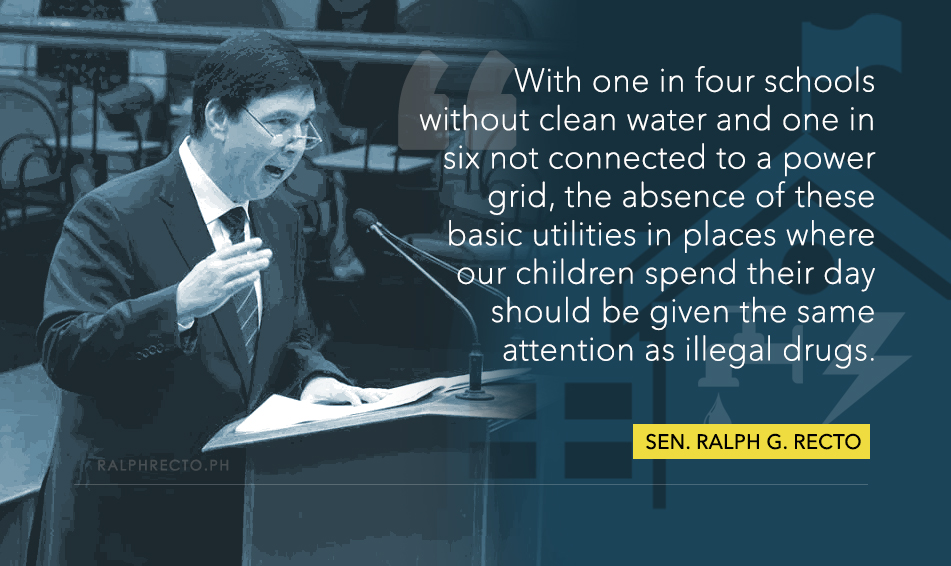Recto : 1 in 4 public schools waterless, 1 in 6 without power
While gains have been made in cutting teacher and classroom shortages, focus should now shift to addressing the lack of water, sanitation and electricity in thousands of public schools, Senate Minority Leader Ralph Recto said.
With one in four schools without clean water and one in six not connected to a power grid, “the absence of these basic utilities in places where our children spend their day should be given the same attention as illegal drugs,” Recto said.
Recto said the rush to bring internet connectivity to schools should not lead us to overlook basic needs such as running water and reliable power.
“Water pipes and power lines are as important as broadband cables,” Recto said. “In fact, electricity is a predicate of ICT-aided education.”
The senator said water and power should now be included in “the scoreboard of school facilities” delivered, together with “traditional items” like books and classrooms.
“Erasing the backlog in water and power is the new frontier in education challenges,” he said.
Recto said “zero-water” schools number 3,628 out of 46,739 nationwide, according to a presentation by the Department of Education (DepEd) last March.
In addition, 8,109 schools primarily rely on rainwater catchment, “which renders them basically water-less,” Recto said. This brings up the real total of water-less schools to 11,737, he said.
Only 18,393 schools nationwide have piped-in water. The next biggest source are deep wells, which 17,757 schools have, Recto said.
“Let’s say three in every five schools lacks reliable, clean piped-in water, and you apply this ratio to the public enrolment of about 20.9 million, then easily about 12.5 million students go to schools with less than reliable water supply,” he said.
With lack of water comes the problem of sanitation facilities, Recto said. “There is a toilet shortage in all schools and you don’t need statistics to back that claim.”
While the previous government had started building more toilets, including classrooms with one, the toilet-to-room gap remains wide, as only a fraction of the 493,669 classrooms nationwide have lavatories, Recto said.
Recto said the availability of water impacts not just the health of students—one survey said 60 percent of gradeschoolers have intestinal worms—but also school-based nutrition programs. “Paano ka magluluto kung wala kang tubig?”
Another basic utility lacking is electricity, with 5,911 schools “with no access to a single watt” in 2013, Recto said. Some 1,492 upland and island schools make do with solar panels or generator sets, bringing up to 7,403 the total number of off-grid schools.
“Ito ‘yung schools na araw-araw mistulang Earth Hour,” he said, referring to the yearly global event when homes and offices switch off electricity for one hour.
“The bright spot in this data is that 899 schools have solar panels installed,” Recto said.
The senator has advocated the mandatory installation of solar panels in all of 46,739 schools, “and using these to power up science laboratories so that students can have an actual example of a science lesson.”
This is so because power, he said, is an indispensable requirement in the drive to wire schools. “Wi-Fi, tablets, computers – they have to be plugged in to a power source.”
Recto said providing clean water and reliable power to schools should now be treated as priority expenditures and must be regularly included in the annual budget of DepEd.
RELATED ARTICLES:
-
03 MAY 2016: Relief sought for 13,740 water-less, electricity-less schools
-
27 APR 2016: Recto: Only P-Noy stamp needed to free P1 Billion for improved water services
-
04 FEB 2016: Water as this elections relevant water issue
-
24 NOV 2016: Tap P170 B Malampaya fund for saltwater lamp production
-
27 JAN 2015: ‘When restos offer free Wi-Fi but not free water, it’s time to strengthen our local water providers’


